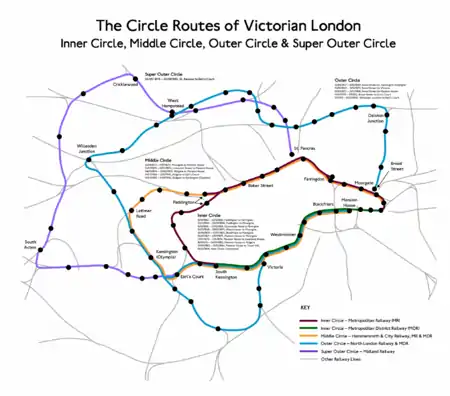Outer Circle (London)
The Outer Circle was a London & North Western Railway service in London that operated from 1872 to 1908. The route was from the District Railway station at Mansion House to Earl's Court, then via the West London Railway to Willesden Junction and then via the North London Railway to Broad Street. Although not a complete circuit, it was one of several 'circle' routes around London that opened at the same time, such as the 'inner circle' that is today's Circle line.[1] Trains would run once every 30 minutes. In 1908 the service was cut back to run from Earl's Court to Broad Street.

The Midland Railway operated a kind of Super Outer Circle from St Pancras to Earl's Court for two years from 1878 to 1880, via the Dudding Hill freight line.
Outer Circle
History
On 1 February 1872 the London & North Western Railway (L&NWR) began a railway service between Broad Street and the District Railway station at Mansion House via the North London Railway, Willesden Junction, the West London Railway and Earl's Court,[2] replacing a service that had run along much of the same route to London Victoria.[3] This service became known as the 'outer circle' and was worked with L&NWR locomotives and carriages and there was a train every thirty minutes.[2] When the District electrified in 1905, it built electric locomotives to haul the carriages between Earl's Court and Mansion House.[4] The service appears on the 1908 'London Underground' map between Earl's Court and Uxbridge Road as a District Railway service.[5]
The service ceased to run east of Earl's Court from 1 January 1909.[4] The L&NWR electrified the West London Railway and an electric service between Willesden Junction and Earl's Court on started 1 May 1914.[4] This was initially with electric multiple units provided by the District Railway until 24 November 1914 when LNWR electric units took over.[6] Passenger services on the West London Railway ended on 19 October 1940 following bomb damage to the line[7]
Uxbridge Road station closed with the line in 1940[7] and Shepherd's Bush opened on the same site in 2008.[8] The line is currently served by the District line between Mansion House and Kensington (Olympia) and then the London Overground to Haggerston.
List of stations
The following stations, listed anti-clockwise, were served by the Outer Circle:
| Station | Closed | Notes |
|---|---|---|
| Broad Street | 1986 | now demolished |
| Shoreditch | 1940 | |
| Haggerston | 1940 | reopened 2010 as part of the London Overground |
| Dalston Junction | 1986 | |
| Mildmay Park | 1934 | |
| Canonbury | ||
| Highbury | opened 1872; now Highbury & Islington | |
| Barnsbury | now Caledonian Road & Barnsbury | |
| Maiden Lane | 1916 | |
| Camden Town | opened 1870; now Camden Road | |
| Kentish Town | now Kentish Town West | |
| Gospel Oak | ||
| Hampstead Heath | ||
| Finchley Road | now Finchley Road & Frognal | |
| West End Lane | opened 1888; now West Hampstead | |
| Brondesbury | ||
| Brondesbury Park | opened 1904 | |
| Kensal Green & Harlesden | opened 1873; now Kensal Rise | |
| Willesden Junction | ||
| Wormwood Scrubs | 1940 | renamed St. Quintin Park |
| Uxbridge Road | 1940 | Shepherd's Bush station opened on the same site in 2008 |
| Addison Road | now Kensington (Olympia) | |
| Earl's Court | ||
| Brompton (Gloucester Road) | service withdrawn 31 December 1908 | now Gloucester Road |
| South Kensington | ||
| Sloane Square | ||
| Victoria | ||
| St. James's Park | ||
| Westminster Bridge | now Westminster | |
| Charing Cross | now Embankment | |
| Temple | ||
| Blackfriars | ||
| Mansion House |
Super Outer Circle
The Midland Railway operated a kind of Super Outer Circle from 1878 to 1880. In 1876 the Midland had negotiated running rights over the Metropolitan District Railway from the London & South Western Railway at Hammersmith to South Kensington. The Midland's main interest was supplying coal to Kensington, and in 1878 it opened coal depots at Kensington High Street and West Kensington.[9] From 1 May 1878 it also ran a passenger service from Earl's Court to St Pancras via Hammersmith, South Acton and the Dudding Hill freight line to Cricklewood. Two trains an hour ran until 30 September 1880.[9][3] The coal depots closed in the 1960s.[9]
References
Notes
- Peacock 1970, p. 48.
- Horne 2006, p. 15.
- Bruce 1983, p. 11.
- Lee 1956, p. 29.
- For the 1908 London Underground Map see File:Tube map 1908-2.jpg.
- Marsden 2009, p. 84.
- Horne 2006, p. 73.
- "Shepherd's Bush Overground station welcomes passengers". Transport for London. 29 September 2008. Retrieved 21 February 2013.
- Horne 2006, p. 18.
Sources
- Bruce, J Graeme (1983). Steam to Silver. A history of London Transport Surface Rolling Stock. Capital Transport. ISBN 0-904711-45-5.
- Horne, Mike (2006). The District Line. Capital Transport. ISBN 1-85414-292-5.
- Lee, Charles E. (1956). The Metropolitan District Railway. The Oakwood Press. ASIN B0000CJGHS.
- Marsden, Colin J (30 January 2009). The DC Electrics. Casemate. ISBN 978-0-86093-615-2.
- Peacock, Thomas B. (1970). Great Western London Suburban Services. Oakwood Press. ASIN B0006C7PD2.
